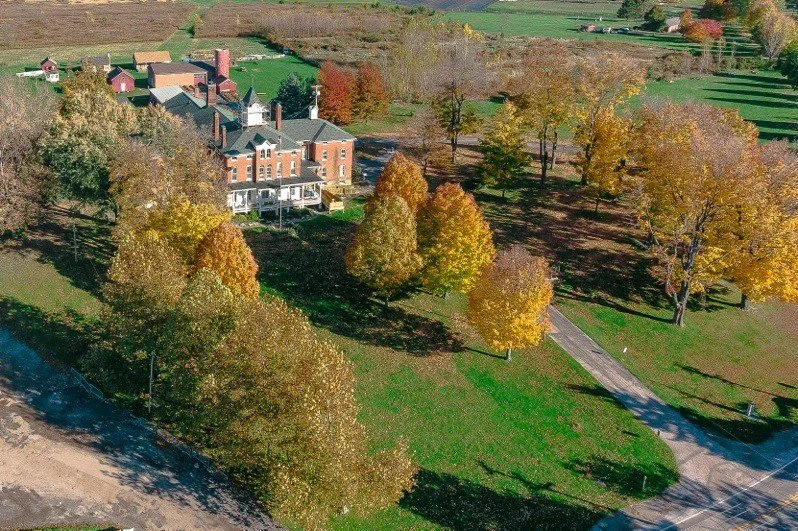A Trip on the Buffalo Post Road, Pt. II
Duncan Virostko, Museum Assistant
Google Maps Directions For This Trip: https://tinyurl.com/mux4mhzd
Continued from Part I:
Lake County History Center (LakeCountyHistoryCenter.org)
After a night at Rider’s Inn, you’ll continue east until you arrive at the Lake County History Centre., located on Riverside Drive. This 8-acre institution preserves the former county “Poor House”, a facility which once served as an institution for the un-homed and mentally ill. The Italianate building was constructed in 1876, designed by Cleveland architect Col. Arthur McAllister, who was well known for designing many mansions on Millionaire’s row. A visit should give the traveler a good idea what Dunham Tavern’s long gone neighbors would have been like in their heyday. The facility continued in operation until 2004, by then housing only nine patients. Today, the Lake County Historical Society preserves the building as a local history museum. It is a rare surviving example of not only such care facilities, but also its original outbuildings as well. The History Center is open to individual public tours only on Saturdays, so you’ll want to plan ahead for this.
Unionville Tavern. ca 1890s. (OldCountyTavern.org)
Unionville Tavern, 1936. (OldCountyTavern.org)
You’ll continue East here, as US 20 becomes SR 84. As you near your destination, you will pass through the small crossroads town of Unionville. Here, “The Old Tavern '' is presently under repair, and recalls Dunham Tavern in its earliest days of preservation, with the community coming together to save the once neglected structure and return it to its full glory. The building started as a mere log dwelling, and over the years expanded into a full blown multi story frame structure. Special events are occasionally held in the Tavern’s gardens, raising funds for the ongoing restoration, but it is largely closed to visitors at time of writing. Across the street from the Tavern, however, is the “Green Door” , a shop offering a selection of fine antiques. Perhaps you’ve seen an artifact in your travels by this point and thought “I’d like one of those for myself!”... Here's your chance to find a lost treasure and take it home with you!
Shandy Hall, built in 1815. (WRHS.org)
To the east of Unionville, in nearby Harpersfield, lies a small, quiet farmhouse with a big history. This is your final destination: Shandy Hall, 6333 South Ridge Road West. It is possibly the least known of the many historical sites of the Western Reserve Historical Society, yet still a gem. Tours are by appointment only, so you’ll need to have called ahead, but the visit will be worth your while. The homestead is one of the oldest frame buildings in Ohio, being constructed in 1815, and was named by Ann Harper, daughter of its builder Col. Robert Harper, after her favorite novel: Tristram Shandy, first published 1759. This was a humorous novel which mocked the solemnity and long-windedness of 18th century literature, and the ways of the upper class. The name thus was no doubt a bit of self deprecation, a style of comedy at which Ohioans excel. Shandy Hall was for 1815 Ohio a lavish mansion, yet it was even by those days’ standards really a modest house compared to structures in the east. So “Shandy Hall” the house became forevermore. Today, it seems an appropriate name for a home of great antiquity and dignity that now reposes in solitude.
So at last, the weary traveler has arrived at their destination. The majority of this route follows Euclid Avenue, US Route 20 and later State Route 84. The trip is some two hours of driving, but many more of museum visiting. For this reason, I planned it to have overnight stop and a two day journey. This will give you, I hope, a sense of the slower pace of travel in the 1800s, and will allow for ample visiting time at the museums and historic sites detailed.
Travel by Stagecoach near Trenton New Jersey, ca 1811-1813, Pavel Petrovich Svinin (The Metropolitan Museum of Art)
Though the roads may now be less traveled, and thus slow and difficult at times to follow, it is useful to think how onerous the trip must have been in the days of stagecoaches when horses panted in the heat, mud and dust choked the roads, and coach bodies jounced precariously suspended on straps of leather, their passengers cramped next to the heavy mail sacks they carried.
A somewhat faster return trip to Cleveland via I-90 is possible, however, so you can retrace your steps at a rather more modern speed!
As research here at Dunham Tavern on the Tavern’s history of service to the traveling public continues and grows, we are working to slowly stitch up the tears between communities which first the railroads and later interstate highways have made. A string of communities in Ohio, Pennsylvania, and New York have a unique and enduring link over the old Buffalo Post Road, a shared history which some small towns in Ohio still remember. As we reach out to, and forge relationships with, other historic sites along the road, we reform the links of an old and rusty chain. It is hoped that, going forward, we may once again be a stop on this old route to Buffalo, a part of a chain of Taverns and other structures which not only tell of a shared past but continue to serve the traveling public in fine old tradition.
Sources:
https://lakehistorycenter.org/
https://www.oldtavernohio.org/
https://www.wrhs.org/do-see/historic-sites/shandy-hall
https://www.metmuseum.org/art/collection/search/12753
https://www.metmuseum.org/art/collection/search/12728







